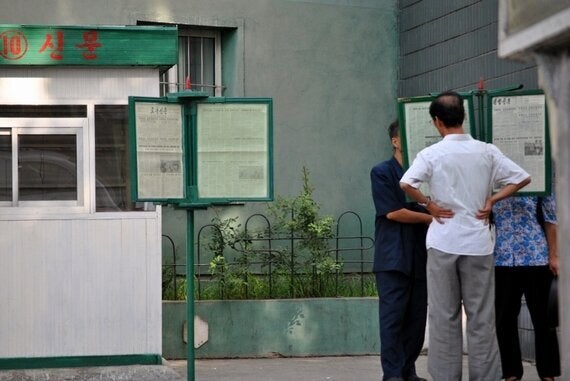The latest big gossip from North Korea recounts the execution of Defense chief Hyon Yong Chol. The General was found guilty of "napping" and insubordination, according to sources from the South Korean National Intelligence Service (NIS). The details of his alleged execution were quite explicit: Hyon Yong Chol was executed on April 29 or 30 "by anti-aircraft machine guns" in the outskirts of Pyongyang. Within hours, world media have reported on the execution and while many North Korean watchers remained skeptical, the news went viral. Details on how the General fell in disgrace and how he made north Korean leader Kim Jong Un furious by "napping" during an event emerged in the press. The "nap" was enough to justify an execution through the use of anti aircraft machinery. This type of execution in North Korea has been reported by the media in the past; the information always comes from sources inside the south Korean intelligence. A recent report of the Committee for Human Rights in North Korea (HRNK) and All Source Analysis on April 29 published satellite images that -according to the authors- indicate the use of such weaponry in executions; However it is difficult to confirm it and there is no conclusive evidence.
Hours after the news went viral, NIS revised its statement. and announced that the General was purged but it cannot confirm his execution. The speculations over "executed for napping" seem to derive from a photo published by North Korea's state Rodong Newspaper on April 26 of Hyon sitting next to Kim Jong Un with the eyes closed. However, ABC reports that "it is unclear whether the photo was taken when he was looking down or falling asleep".

North Koreans reading the state Rodong Newspaper in the streets of Pyongyang
We all remember the details of another execution, this of Jang Song Thaek who was "eaten alive by 100 hungry dogs" ; the news went viral only to find out later that it was a fake report originated from a satirical Chinese site.
Jang Song Thaek was indeed executed; but he died from firing squad and was not eaten alive by dogs. Journalists opted for the "dog version" as it was much more "catchy".
In June 2013, the world was shocked by the "execution" of Hyon Song-wol, a well known artist in North Korea. The media could not just get enough of this story that had it all: clandestine porn production in China, illegal love affairs and a tragic death when Ri Sol Jul, Kim Jong's Un wife, eaten up with jealousy asked her powerful husband to execute the singer.
Back then, I was still living in North Korea. Not long before the alleged execution, on March 8, I was invited-together with other members of the diplomatic community in Pyongyang -to attend a concert that marked Women's Day. Hyon Song -wol, visibly pregnant at that time, was performing at the event.
Three months later the media reported on her execution. To add more credibility, a top south Korean official said that NIS was "aware of the execution".
I seriously confronted those reports. The execution of a pregnant woman would be too big for journalists to ignore but all media failed to mention the singer's pregnancy. A year later the singer, very much alive, appeared on the north Korean state channel proudly wearing the uniform of a north Korean army colonel.
In 2013 another execution monopolized the media's attention. This time was Yi Su-yong who- apparently alive-serves today as North Korea's foreign minister.
in 2012 Kim Chol, a senior Army official, was allegedly executed. This time, we were told that he was exploded by mortar bombardment. Although his fate is still not confirmed, the use of mortars in his execution is fabricated. Very spectacular execution indeed.
Again back in 2013 and a short film entitled "How Americans Live" goes viral. This time it was "a DPRK propaganda video" supposedly showing to north Koreans the depredations of western societies, such as people in the US eating snow to survive. Nobody questioned that video and Washington Post published a lengthy analysis declaring the video authentic and its "message consistent with North Korean propaganda." But there was a problem with that. The "authentic" video was fake. It was later revealed that British travel writer Alun Hill had created the video as a satirical film.
When Kim Jong Un did not appear on the state media for three weeks -due to health issues -stories on how he became sick emerged; the media were able to diagnose that Kim Jong Un became sick because he "eats too much Swiss cheese". The cheese in question was emmental cheese and the story went viral once again.

Women chatting in the left bank of Taedong River in Pyongyang
There is a global appetite for North Korean news and the more explicit and gruesome the story is, the better it gets.
The country's supposed weirdness fascinates media to a point that they forget all standards of journalism when they report on North Korea. The audience used to exaggerated narratives rarely doubts the information. This is North Korea; anything can happen there.
As a result, North Korea is routinely portrayed as a cartoon caricature and north Koreans are depicted as an ignorant, hungry population, cut off from the rest of the world, despite the fact that several accounts point to the opposite. A dynamic and expanding middle class is now playing a major role to the country's transformation and although malnutrition persists, people are clearly better fed compared to the past.
With universal school enrolment and universal literacy and more than one third of the graduates holding a university degree (seven out of ten in science, health and engineering), north Koreans are far from being "naïve ignorants" with no knowledge of the outside world.
Even foreigners enjoy much more freedom in the country than what is generally believed. Although tourists have restricted movement, long-term resident are permitted to obtain North Korean driving licenses and drive around undisturbed, learn Korean and freely operate without being monitored.
Certainly, North Korea is notoriously opaque, with strict controls on information and a censored state media. Foreign journalists -with the exception of AP and Chinese and Russian agency- are not granted access to the country. Information brought together with much imagination and gossip, comes out from intelligence officials or diplomats and is then channeled to journalists working in South Korea or Japan.
A political agenda is often hidden behind those reports. In other instances gruesome details of executions of officials could be circulated intentionally by the north Korean intelligence as a warning and a reminder to ambitious members of the army that the leadership is not to be challenged.
Defectors accounts should be equally treated with caution. Although those accounts constitute a first hand information and document human rights abuses, there has been a growing criticism over the accuracy of some testimonies. In some instances defectors have recanted their own narrative while other accounts have been publicly challenged.
What one should keep in mind is that the debate over North Korea is heavily politicized. Information is crucial and can highlight human rights abuses and lead to policy changes. But fabricated and erroneous reporting can have grave consequences on the lives of ordinary north Koreans, that are being punished for the acts of a government that they have no control of.
Misguided reporting and the cartoon picture of North Korea shifts the attention from the important changes that taking place inside North Korea and hampers our understanding of their political impact.
